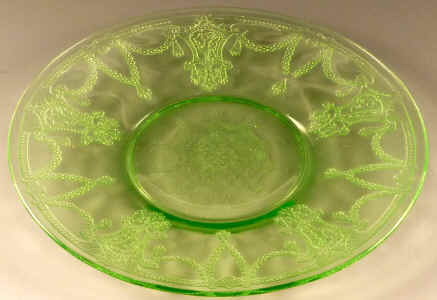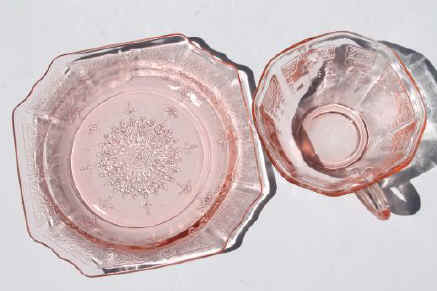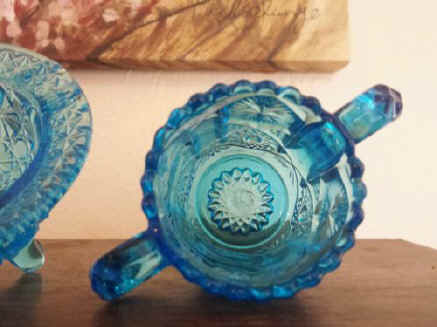 From
the late 1920's through the early 1940s, manufacturers such as Hazel
Atlas Glass Company, Hocking Glass Company, Federal Glass Company,
Indiana Glass Company, MacBeth-Evans Glass Company, Jeannette Glass
Company, Imperial Glass Company, Lancaster Glass Company, U.S. Glass
Company, and L. E. Smith Glass Company, brought a little cheer into some
very dreary days by manufacturing the product we now know as Depression
glass. This mass-produced molded glassware was of relatively poor
quality, often exhibiting air bubbles, heavy mold marks and other flaws
in the glass, yet it came in beautiful colors and patterns to suit every
taste. At a time when a loaf of bread cost about a nickel, frugal
shoppers could also buy a piece of Depression glass for around the same
price.
From
the late 1920's through the early 1940s, manufacturers such as Hazel
Atlas Glass Company, Hocking Glass Company, Federal Glass Company,
Indiana Glass Company, MacBeth-Evans Glass Company, Jeannette Glass
Company, Imperial Glass Company, Lancaster Glass Company, U.S. Glass
Company, and L. E. Smith Glass Company, brought a little cheer into some
very dreary days by manufacturing the product we now know as Depression
glass. This mass-produced molded glassware was of relatively poor
quality, often exhibiting air bubbles, heavy mold marks and other flaws
in the glass, yet it came in beautiful colors and patterns to suit every
taste. At a time when a loaf of bread cost about a nickel, frugal
shoppers could also buy a piece of Depression glass for around the same
price.
Depression glass also made its way
into American homes through the issuance of premiums. Sellers or
manufacturers would offer a free gift with the purchase of a certain
dollar amount of goods or a specific product, and penny-pinching ladies
took full advantage of these freebies.
Glass was plucked from an oatmeal box
one week, from a detergent box the next. Sometimes gas stations would
throw in a punch bowl and cups with an oil change. Movie theaters got in
on the action offering a piece of glass with a ticket to a Saturday
matinee. Some businesses would give away one piece of glassware to each
customer just for coming in the door..
 Another
category of "Depression era" glass, usually handmade with more
care and thus higher quality, is more accurately labeled "Elegant
Glass", as produced by such companies as Westmoreland Glass
Company, Imperial Glass Company, Fostoria Glass Company, A. H. Heisey
& Company, and others. An easy way to compare the difference in
color quality is to take a look at a piece of cobalt Elegant Glass and
place it alongside a piece of cobalt Depression Glass. The intensity of
the former piece is quite evident. Pressed Elegant Glass was fire
polished to get rid of the flaws in the glass. The normal flaws found in
pressed glass - straw marks, raised seams, etc. were removed. The base
of bowls, platters, etc. was ground so it would sit evenly on a table.
Many patterns of Elegant Glass were embellished with acid etching,
cutting, enamel decoration, gold encrustation, platinum and gold trim.
Another
category of "Depression era" glass, usually handmade with more
care and thus higher quality, is more accurately labeled "Elegant
Glass", as produced by such companies as Westmoreland Glass
Company, Imperial Glass Company, Fostoria Glass Company, A. H. Heisey
& Company, and others. An easy way to compare the difference in
color quality is to take a look at a piece of cobalt Elegant Glass and
place it alongside a piece of cobalt Depression Glass. The intensity of
the former piece is quite evident. Pressed Elegant Glass was fire
polished to get rid of the flaws in the glass. The normal flaws found in
pressed glass - straw marks, raised seams, etc. were removed. The base
of bowls, platters, etc. was ground so it would sit evenly on a table.
Many patterns of Elegant Glass were embellished with acid etching,
cutting, enamel decoration, gold encrustation, platinum and gold trim.
Elegant Glass was sold in the finer
stores, never given away. It was also marketed as wedding patterns. It
was offered as an alternative to china and crystal which were still
imported due to manufacturing costs and were incredibly expensive. Many
consumers purchased Elegant Glass and placed it on display, only using
it for very special occasions.
 Due
to its popularity as a collectible, authentic Depression glass is
gradually becoming more scarce on the open market, although auction
sites such as ebay have revealed large quantities of pieces in various
patterns that had previously been unavailable to the average collector
with only local or regional antique shops and flea markets to browse
through for finds. Some manufacturers continued to make the most popular
glass patterns after World War II, or introduced similar patterns, which
are also collectible.
Due
to its popularity as a collectible, authentic Depression glass is
gradually becoming more scarce on the open market, although auction
sites such as ebay have revealed large quantities of pieces in various
patterns that had previously been unavailable to the average collector
with only local or regional antique shops and flea markets to browse
through for finds. Some manufacturers continued to make the most popular
glass patterns after World War II, or introduced similar patterns, which
are also collectible.
Some of the most common pieces in a
plentiful pattern may sell for only a few dollars, but rare pieces in
certain patterns can sell for hundreds of dollars at depression glass
shows. Some Depression pieces are hard to classify as to the exact
pattern name, or might be called "generic" pieces, such as
some rather plain-looking sugar bowls, salt shakers, ashtrays or other
items that donít seem to match any photos in depression glass price
guidebooks
The most popular colors with
collectors today are pink in varying hues, cobalt blue and green. Some
of the most popular patterns buyers seek today are Cameo, Mayfair,
American Sweetheart, Princess and Royal Lace. Even the pattern names
alluded to better times and a longing for the glamorous lifestyles of
the 1920s.
Illustrations from top to bottom:
Cameo Depression Glass Green 6 Inch Sherbet Plate Hocking Ballerina Dancing
Girl
Princess pink depression glass 1930s vintage Anchor Hocking plates &
cups
imperial glass depression footed ashtray